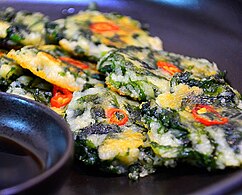For other uses, see Laver (disambiguation).
| This article needs additional citations for verification. Please help improve this article by adding citations to reliable sources. Unsourced material may be challenged and removed. Find sources: "Green laver" – news · newspapers · books · scholar · JSTOR (January 2024) (Learn how and when to remove this message) |

Green laver (/ˈleɪvər, ˈlɑːvər/), known as aonori (アオノリ; 青海苔) in Japan, sea cabbage (海白菜) or hutai (滸苔) in China, and parae (파래) and kim (김) in Korean, is a type of edible green seaweed, including species from the genera Monostroma and Ulva (Ulva prolifera, Ulva pertusa, Ulva intestinalis). It is commercially cultivated in some bay areas in Japan, Korea, and Taiwan, such as Ise Bay. It is rich in minerals such as calcium, magnesium, lithium, vitamins, and amino acids such as methionine. It is also called aosa (アオサ, Ulva pertusa) in some places in Japan.
Culinary use
| This section needs additional citations for verification. Please help improve this article by adding citations to reliable sources in this section. Unsourced material may be challenged and removed. (January 2024) (Learn how and when to remove this message) |
Japan
It is used in its dried form for Japanese soups, tempura, and material for manufacturing dried nori and tsukudani and rice. It is also used in a powdered form, often blended with Ulva species of Ulvaceae as its production is limited.
It is used commonly for flavouring of some Japanese foods, usually by sprinkling the powder on the hot food, for its aroma:
- Fried noodles (yakisoba or yakiudon)
- Okonomiyaki (Japanese pancake)
- Takoyaki (octopus dumpling ball)
- Isobe age
- Isobe mochi
- Shichimi (seven-spice seasoning)
- Japanese potato chips
- Misoshiru
-
Raw aonori from Lake Hamana
-
Miso soup with raw aonori
-
 Okonomiyaki with aonori powder
Okonomiyaki with aonori powder
-
 Yakisoba with aonori powder
Yakisoba with aonori powder
Korea
In Korea, parae is eaten as a namul vegetable. It is also used to make gim (dried laver sheets).
-
 Parae-gamja-jeon (green laver potato pancake)
Parae-gamja-jeon (green laver potato pancake)
-
 Parae-muchim (seasoned green laver)
Parae-muchim (seasoned green laver)
-

-
Dried green laver sheets
Similar species
Green laver shares the name "laver" with Porphyra umbilicalis, a red seaweed, which is harvested from the coasts of Scotland, Wales, and Ireland and used to prepare laverbread. Like "green laver", similar edible seaweeds with indigenous names translated as "laver", are found in many other countries around the world. In Hawaii, "the species Porphyra atropurpurea is considered a great delicacy, called Limu luau".
See also
References
- "About 'aosanori'". isekanbutsu. Archived from the original on 14 May 2017. Retrieved 25 May 2017.
- ^ Harford, Robin (30 August 2018). "Laver Seaweed – A Foraging Guide to Its Food, Medicine and Other Uses". eatweeds.co.uk. Archived from the original on 21 January 2021. Retrieved 22 March 2021.
External links
 Media related to Green laver at Wikimedia Commons
Media related to Green laver at Wikimedia Commons- Seaweeds used as human food
- Mystery Seaweed and Aonori
| Japanese food and drink | |||||||||
|---|---|---|---|---|---|---|---|---|---|
| Shushoku |
| ||||||||
| Okazu | |||||||||
| Soup (Shirumono) | |||||||||
| Set menu | |||||||||
| Beverages |
| ||||||||
| Snacks / desserts/ Wagashi | |||||||||
| Fruits | |||||||||
| Ingredients / condiments | |||||||||
| Utensils | |||||||||
| Lists | |||||||||
| Related | |||||||||
This vegetable-related article is a stub. You can help Misplaced Pages by expanding it. |
This Korean cuisine–related article is a stub. You can help Misplaced Pages by expanding it. |
This Japanese cuisine–related article is a stub. You can help Misplaced Pages by expanding it. |